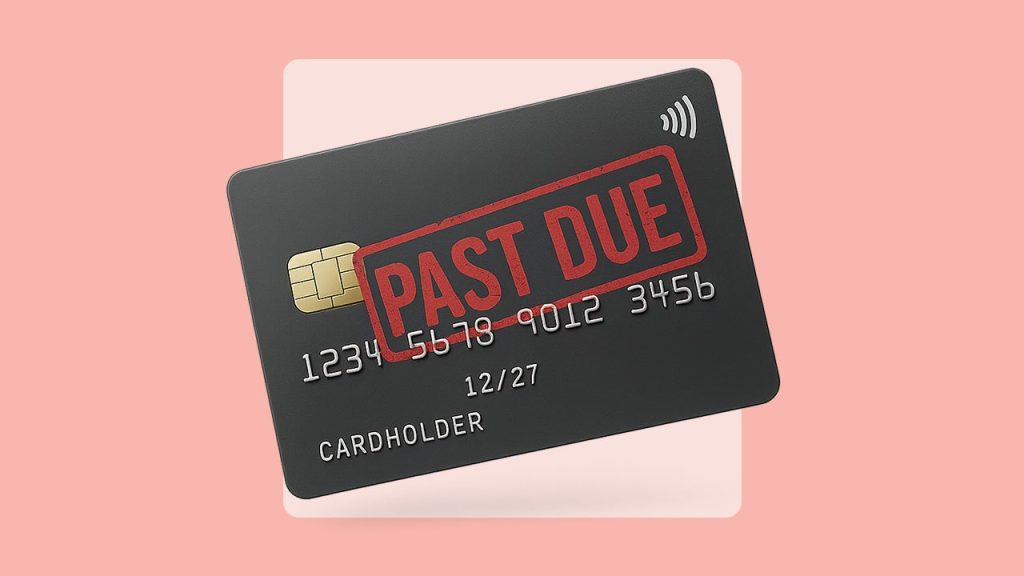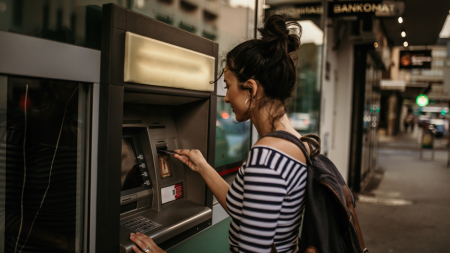The credit card delinquency rate has decreased for three straight quarters after hitting its highest point in more than a decade. According to the Federal Reserve, 3.05 percent of credit card balances were delinquent (30+ days past due) as of Q1 2025. The recent peak was 3.24 percent in the second quarter of 2024, the highest since the fourth quarter of 2011.
Charge-offs occur when payments are so late that the lender has essentially given up on collecting that money (for credit cards, a typical threshold is 180 days past due, although sometimes charge-offs can occur sooner, such as after 90 or 120 days).
The charge-off percentage has followed a similar pattern to delinquencies, hitting its highest point since late 2011 (4.69 percent) during the second half of last year and then tailing off a bit (to 4.44 percent at last check). Serious delinquencies often turn into charge-offs, since it’s increasingly unlikely that someone who is 60 then 90 then 120 days late will be able to get back on track quickly. Conventional wisdom is that the credit card charge-off rate more or less matches the unemployment rate.
Delinquency vs. charge-off
A delinquency is when you’re a little late with a payment (perhaps 30, 60 or 90 days late). A charge-off is more like a default — you’re so late the lender writes off the loan as a loss (although they can still pursue payment via certain avenues, such as suing you or turning the bill over to a collections agency).
Card issuers haven’t appeared particularly concerned about the sizable run-up in delinquencies and charge-offs that have occurred in recent years. They’ve generally viewed this transition as “normalization” after unusual lows during the pandemic.
Have a question about credit cards? E-mail me at [email protected] and I’d be happy to help.
How the COVID-19 pandemic affected credit card delinquencies and defaults
The charge-off rate bottomed at 1.63 percent in Q4 2021, the lowest in a Federal Reserve data set that stretches way back to 1985. The credit card delinquency rate hit its nadir a quarter before that (1.53 percent). A dominant theory is that Americans used COVID-era economic stimulus payments to pay down debt, plus many people spent less during the pandemic (as travel and large public gatherings were curtailed, along with many other temptations to spend).
Optimism has followed
The mood within the credit card industry has generally been pretty upbeat the past few years, although not everything has been rosy. While spending and profits are up, card issuers have also tightened lending standards and pulled back on juicy sign-up bonuses.
Credit card originations fell 4.3 percent from 82.1 million in 2022 (a record high) to 78.6 million new accounts in 2023. The decline steepened from 2023 to 2024, when just 71 million new accounts were opened (a 9.7 percent year-over-year drop). That still eclipsed 2019 (69.4 million accounts) and every other year prior to the pandemic. This year has begun on a similar footing, with January and February originations down from last year but still ahead of pre-pandemic levels.
American Express, which caters to a more affluent and creditworthy customer base than many of its rivals, shared this positive take during its latest earnings call in April:
Both delinquency and write-off rates were below pre-pandemic levels and flat to the prior year. The profile of the portfolio has strengthened over the past few years. Looking at our recent acquisitions, the delinquency rate of low-tenure customers, defined as those with 24 months or less of tenure, is about 30 percent lower than 2019 levels for U.S. consumer card members.
— Christophe Le Caillec, American Express Chief Financial Officer
Synchrony Financial often plays at the other end of the sandbox. Store credit cards are a big part of its business, and these tend to be easier to obtain. Providers of store cards (including Synchrony) are generally less selective about credit quality; they compensate by charging higher interest rates. Synchrony’s delinquency rate is noticeably higher than Amex’s, but it still stacks up favorably to pre-pandemic times. Here’s what Synchrony’s Chief Financial Officer, Brian Wenzel, said during their April earnings call:
At quarter-end, our 30-plus delinquency [rate] was 4.52 percent, a decline of 22 basis points from 4.74 percent in the prior year and four basis points below our historical average for the first quarter of 2017 to 2019. Our 90-plus delinquency rate was 2.29 percent, a decrease of 13 basis points from 2.42 percent in the prior year and one basis point above our historical average for the first quarter of 2017 to 2019.
— Brian Wenzel, Synchrony Chief Financial Officer
Wenzel added that charge-offs remain a bit of a problem (although the declining delinquency rate likely foreshadows improvement in this metric):
“Our net charge-off rate was 6.38 percent in the first quarter, an increase of 7 basis points from 6.31 percent in the prior year and 54 basis points above our historical average in the first quarter of 2017 to 2019.”
Meanwhile, in the middle-market segment, Bank of America is a good proxy. The bank is relatively upbeat as well, as evidenced by these April earnings call comments by CFO Alastair Borthwick:
Now 90 percent of our consumer net charge-offs are driven by credit card, which highlights the importance of prudence in underwriting that portfolio … Near-term, we don’t expect much change in net charge-offs as you can see improvement in both early and late-stage delinquencies from the fourth quarter. That tells us the net charge-offs could even be a touch lower next quarter on the consumer side.
— Alastair Borthwick, Bank of America Chief Financial Officer
We can summarize these perspectives by saying that credit card issuers are generally feeling pretty good about where things stand right now, yet there is plenty of economic uncertainty, of course. When it comes to forecasting the effects of tariffs and recession worries on the job market, consumer spending, delinquencies and (ultimately) defaults, the crystal ball is pretty cloudy.
This is why, even as banks portray relative calm, they’re not sticking their necks too far out there. It has become harder for some Americans to access credit, particularly those with lower credit scores and lower incomes. And the arms race to acquire big-spending, highly creditworthy customers hasn’t been as robust in recent years, with sign-up bonuses mostly in the good but not great category.
Student and auto loan delinquencies are the biggest trouble spots
I’m much more concerned about student and auto loan delinquencies than late payments on credit cards. TransUnion says a record 20.5 percent of federal student loan borrowers with a payment due were 90 days or more late as of February, a figure that is highly likely to grow in the months ahead. Federal student loan payments were suspended from early 2020 until late 2023, with an additional one-year penalty-free on-ramp until late 2024. That long lag explains why we’re just seeing the tip of the iceberg now. Around July 1 is when we’re going to start to see a spike in defaults (approximately 270 days since the on-ramp expired).
The auto loan delinquency rate, meanwhile, is at its highest level since the financial crisis more than 15 years ago, according to Morningstar. The rapid run-up in vehicle prices, auto loan rates and car insurance costs has been a nasty combination.
The bottom line
Even though it’s unsecured debt and therefore generally considered riskier than debts backed by assets such as homes and cars, the credit card market is holding up pretty well, but there is plenty for us to monitor in the months ahead.
There’s a potential spillover effect to all of this, too. For instance, if you don’t have the money to pay your student or auto loan, you might not be able to pay other bills. Or you might rely on credit cards as an emergency fund of sorts, piling up debt that could be difficult to repay later on. This is all contributing to elevated levels of economic uncertainty and helps explain why issuers are holding their cards a bit closer to the vest, opening fewer new accounts, trimming sign-up bonuses and keeping a watchful eye on the economic storm clouds.
Why we ask for feedback
Your feedback helps us improve our content and services. It takes less than a minute to
complete.
Your responses are anonymous and will only be used for improving our website.
Help us improve our content
Read the full article here









